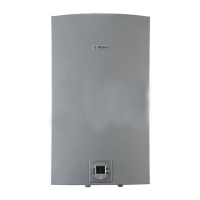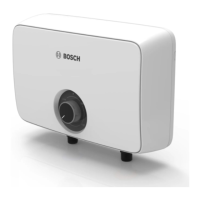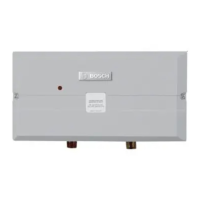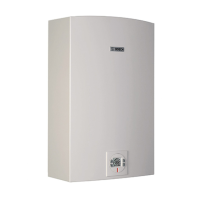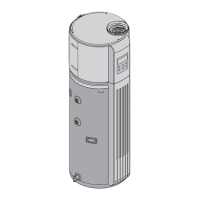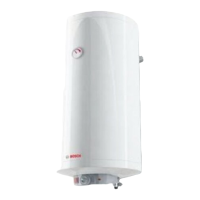Troubleshooting
C 950/C 1050 (Pro TL 175 C/199 C) – 6 720 805 440 (2019/10)
64
supply to the water heater. Then open all of the hot water
taps served by the heater. Wait 10 minutes and check for
water flow at each tap. There should be no water flowing.
Any continuous flow of water, small or large, indicates a
crossover is present and must be corrected. Consult a
professional plumber for help in correcting a crossover.
Failing single lever faucet mixing valves are common causes
of plumbing crossovers.
8. With the power button pressed switch turned to OFF and
the power supply cord unplugged, remove the unit's front
cover (See fig. 3, page 12). Check wire connections
between the water valve, control unit and electrode set.
See chapter 13.2, page 76 for location of these parts.
9. Water heater in solar mode. If inlet water temperatures
exceed the water heater's set temperature, the burners will
not ignite and the solar mode indicator will show on the
display. See page 57, page 52.
8.3 Water is too hot
1. Selected temperature on the unit is too high. To lower
output temperature, see chapter 6.4, page 53.
2. Clean inlet filter screen per chapter 7.1, page 56 to
increase flow through the heater.
3. Inspect the water path for obstructions. Make sure all
shower heads, faucet aerators and whole house filters are
clear of debris.
4. Confirm the heater's gas type coincides with the type of gas
being supplied. See fig. 2, page 11 for location of rating
plate.
5. Avoid restrictive outlets. Clean all shower heads and faucet
aerators. It may be necessary to upgrade to higher flow rate
shower heads if allowable by local code.
6. In areas where the water has a high mineral content,
periodic descaling may necessary. See chapter 7.3,
page 57 for directions.
8.4 Water is not hot enough
1. Selected temperature on the unit is too low. To raise output
temperature, see chapter 6.4, page 53.
2. Clean inlet filter screen. See chapter 7.1, page 56 to
increase flow through the heater.
3. Inspect the water path for obstructions. Make sure all
showerheads, faucet aerators and whole house filters are
clear of debris.
4. Confirm the heater's gas type coincides with the type of gas
being supplied. See fig. 2, page 11 for location of rating
plate.
5. Check inlet gas particle screen for blockage at gas inlet
connection on bottom of unit.
6. Verify gas pressure is in accordance with specifications in
chapter 4.14, page 49. A gas pressure reading is needed to
proceed further. Contact your original installer or a local
certified gas technician to obtain this reading.
7. Cold water is mixing into the hot water lines (plumbing
crossover). A plumbing crossover can unintentionally mix
cold water with the hot water leaving the heater. The end
result is a cooler water temperature than desired. To check
for a plumbing crossover, shut off the cold water supply to
the water heater. Then open all of the hot water taps served
by the heater. Wait 10 minutes and check all taps for water
flow. There should be no water flowing. Any continuous
flow of water, small or large, indicates a crossover and must
be corrected. Consult a professional plumber for help in
correcting a crossover. Failing single lever faucet mixing
valves are common causes of plumbing crossovers.
8.5 Low water flow/pressure
1. Too many hot water applications are being used
simultaneously or too much flow is demanded. The water
heater will effectively support two 2.0-2.5 GPM shower
heads simultaneously or multiple sink applications. Greater
draws will result in a water pressure drop and reduced flow
at taps.
2. Ensure that gas pressure is in accordance with
specifications in chapter 4.14, page 49. A gas pressure
reading is needed to proceed further. Contact your original
installer or a local certified gas technician to obtain this
reading. If gas pressure is inadequate, the water heater will
close its motorized water valve, reducing the hot water flow
rate in an attempt to reach the selected output
temperature.
3. If selected temperature on the unit is set too high for the
demanded flow rate, the water heater will close its
motorized water valve, reducing the hot water flow rate in
an attempt to reach the selected output temperature.
Lowering the selected temperature will allow the motorized
water valve to open up for increased water flow rate.
4. Clean inlet filter screen per chapter 7.1, page 56.
5. Inspect the water path for obstructions. Make sure all
shower heads, faucet aerators and whole house filters are
clear of debris.
8.6 Hot water temperature fluctuates at tap
1. Hot water is very hot out of the water heater, requiring
mixing in cold water in order to attain a usable hot water
temperature. The addition of too much cold will overpower
hot water flow from the tankless water heater.
If this slows the flow through the tankless water heater

